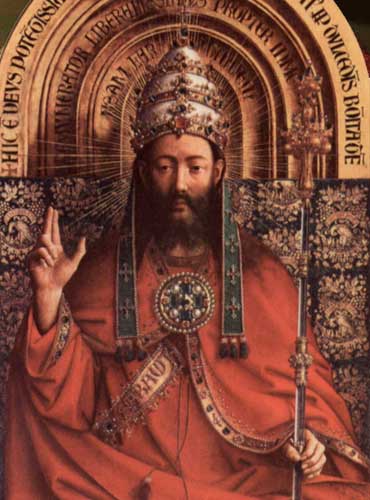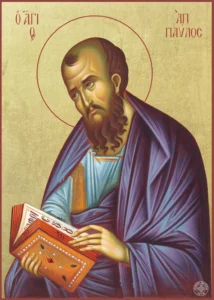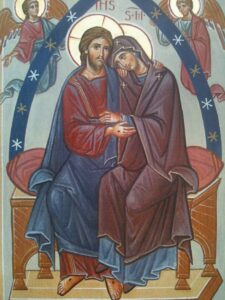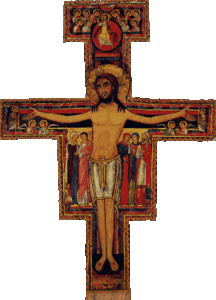A. In the entire Universe There Is Nothing Greater than Jesus Christ
For its stage, the Incarnation had a tiny planet, lost among millions of stars and thousands of galaxies, but, because of the Incarnation, this planet is the real center of the universe. Human history is like a play in which, despite many scenes and characters, only one idea develops: salvation in Christ, the Savior.
Jesus Christ, the center of the physical universe, is also the center of the moral universe; He is its beginning and end, and the most profound reason for all human conversions, because He is the head of the redeemed humanity.
B. There Is Nothing Greater in Jesus Christ than His Sacrifice[2]
Condren states: “God’s masterpiece is Jesus Christ and Jesus Christ’s masterpiece is His Church. . . . But there is something that is the greatest, the most holy, and the most august in Jesus Christ and in the Church . . . this is the priesthood and the Sacrifice of Jesus Christ.”[3] From the moment He became man, the Eternal Word, the perfect image of the Father and the exemplar cause of creation, will never cease being the bond, the link, be-tween God and creation; He can never quit His work as mediator.
He is the only priest, always a priest, and a priest in all parts (totally a priest), because His consecration was not a passing and accidental event, an anointing received on one of the days of His existence. Rather, His consecration was His very Divinity that was communicated to His assumed human nature from the beginning of all of His days.[4]
Accordingly, Jesus Christ is a priest in His essence, and all of His actions were necessarily priestly:
- He could pronounce only one word: a word of reparative adoration.
- He could perform only one act: priestly oblation.
- He had only one figure in His Soul: the Cross.
- Only one movement animated His existence: the ascent of Calvary.
All the acts in Christ’s life are related, not by casual convergence, but rather by the internal finality of the sacrifice of the Cross. Saint Luke reveals this in a mysterious phrase: [Christ] resolutely determined to journey to Jerusalem (9:51) (et ipse faciam suam firmavit ut iret Ierusalem). The constant attitude of His entire life was to go to Jerusalem: the Priest tended towards His altar.
In the eyes of secular history, Calvary was nothing more than an insignificant hill that just barely stuck out of the dirt of Jerusalem. It was a mound in the background of a forgotten place, outside of the paths of civilization. It was a drama of hate and jealousy, of meanness and cruelty, of people who cried in a small paved plaza one conviction among many others, a miniscule incident that was forgotten in the murmur of the Passover feast, an incident that might barely merit even a single line from the writers of the era.
In God’s eyes, that is, in reality, Christ’s sacrifice is the real constructor of history; it is the center at which everything converges and from which everything radiates. It is the only event that gives meaning and unity to all other events.
In effect, the sacrifice towards which Christ’s life was directed is a poem of the strictest unity. While in all other pagan and Jewish sacrifices the elements were separated, Christ, in His sacrifice, reduces everything to unity:
- in place of innumerable oblations, only one oblation;
- in place of many sacrificed animals, only one victim;
- in place of thousands of sacrificers, only one priest;
- in place of the irreducible dualism of a priest who is not a victim and of a victim who cannot offer himself, a priest who is the victim of His sacrifice: priest and victim, Priest of His Victim and Victim of His Priesthood;
- in place of a conventional vicar and insufficient institution, one single priest who, in His position as Head, reunites all men in Himself to offer them as one single holocaust.[5]
The confused murmuring of the ancient sacrifices–figures of the Passion–in the proximity of Golgotha became a distinct clam-or, a clamor that broke and quieted into the silence of the ninth hour. In that instant, the veil of the Temple was torn and the work of our redemption was completed: For by one offering he has made perfect forever those who are being consecrated (Heb10:14).
All religion of the past and the future was contained in Jesus’ sacrifice. On account of the supreme act of worship carried out there, the cross, the altar of the world, becomes the religious unity of the world: ara mundi, and, as such, unitas mundi.
Protestantism has not understood this aspect of the truth very well, and has rejected the idea of daily sacrifice. Starting four centuries ago, it has shouted that the Mass is an abomination, a sacrilegious assault on the infinite value of Christ’s death. What Protestantism does not understand, however, is that God’s works are perfect. On account of the intimate solidarity that exists between the Head and the members, it was necessary that the sacrifice of the cross, while remaining one and absolute, pass into the Church’s daily life, extending itself to all times and all places without multiplying itself.
Remaining one and absolute, encompassing all times and places, and being participated in by all men from all the different eras of humanity, the Holy Sacrifice of the Mass perpetuates the double motion of the redemptive Incarnation: a movement from heaven to earth for the sanctification of men (the descending movement), and a movement from the earth to heaven for the glorification of God (the ascending mediation).
In the entire universe there is nothing greater than Jesus Christ.
- There is nothing greater in Jesus Christ than His sacrifice.
- He is not just the one and only Victim.
- He is not simply the one and only Priest.
- He is also the one and only oblation.
In that culminating moment, in which the Savior was on the summit of Golgotha, in a panoramic vision, illuminated by the beatific vision, He knew–one by one–all of the oblations, each and every one of the transubstantiations that the Church would make of His expiatory death with the Eucharistic rite, and all of them–also this one[6]–as a group, He made His own, presenting them to the Father.
In that moment, the status viae ended for Christ, and the status gloriae began. Therefore, His disposition, continually fed with acts of oblation, was in that moment changed into a state of permanent oblation (status oblationis perpetuus), a state almost crystallized in the participated immutability of glory. Jesus remains present on the altar with this same disposition of oblation in His Divine Heart.[7]
We participate from this one oblation (of the cross and of the altar) with renewed joy every time we attend Holy Mass.
[1] Cfr. Antonio Piolante, I Sacramenti (Rome 1959) 516.
[2] Cfr. P. Parente, De Verbo Incarnato (Rome 1955) 73-77.
[3] Ch. De Condren, L’idée du sacerdoce et du sacrifice de Jesús-Crist (Paris 1901).
[4] P. Parente, o. c.
[5] Cfr. Saint Augustine, De Trinitate, 4, 14; PL. 42,901.
[6] The text is clearly from a homily being read at Mass.
[7] Cfr. R. Garrigou-Lagrange, An Christus non solum virtualiter sed actualiter offerat Missas, quae quotidie celebrantur, in Angelicum, 19 (1942) 105-118.







